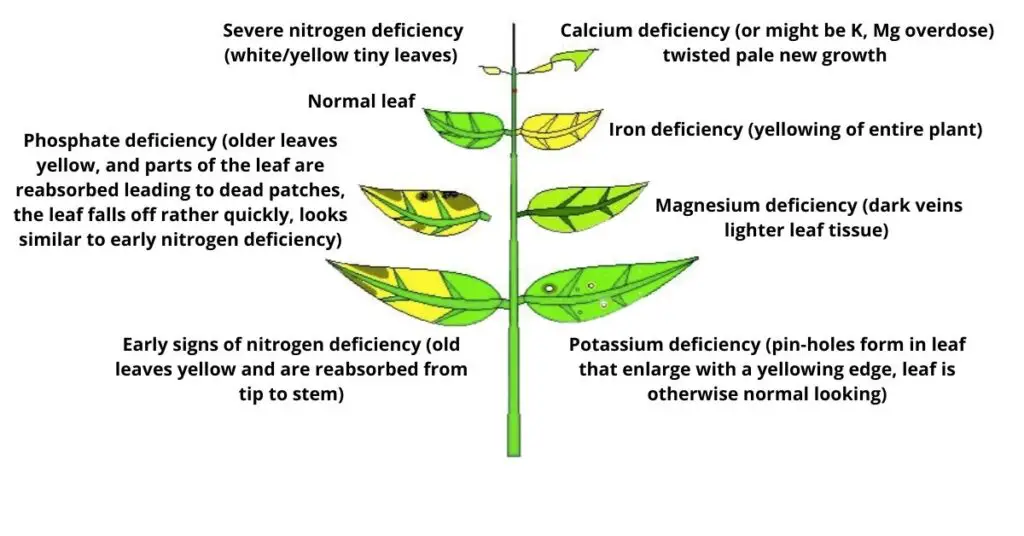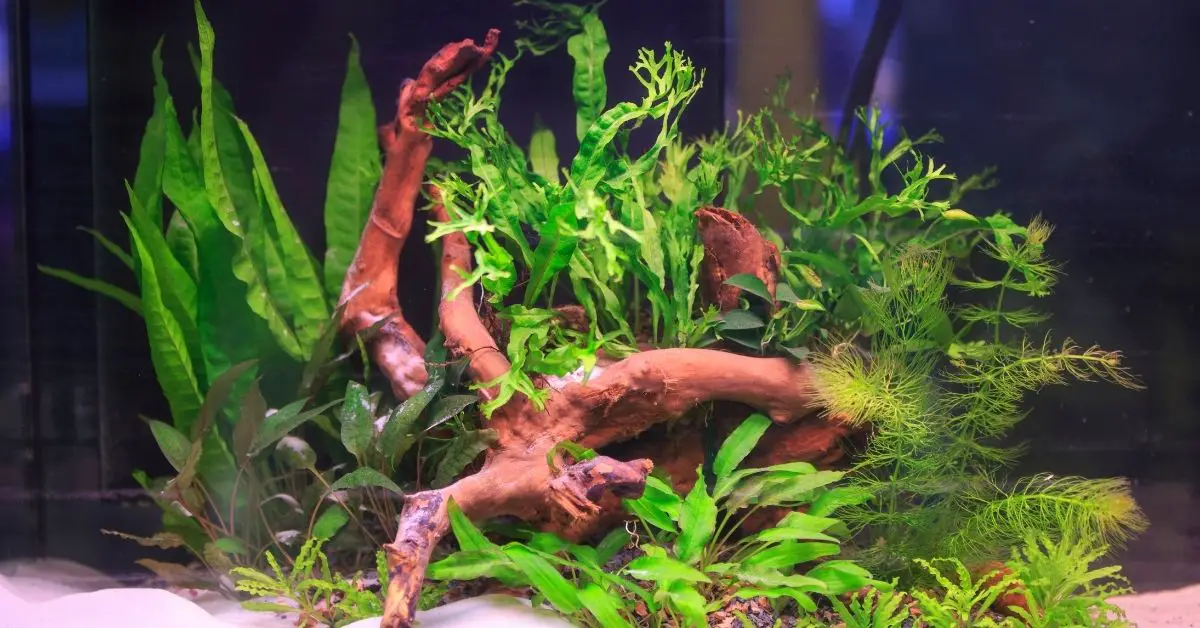There isn’t one answer to what causes holes in aquarium plants, but there are things you can do to fix or avoid the problem. Cryptocorynerot, lack of food or nutrients, or even snails can all contribute to creating holes in your plants’ leaves, so here’s what that means and how to avoid it.

Cryptocoryne Rot
Crypt, or the scientific name of cryptocoryne rot is a condition that’s known to cause holes, though there’s not one specific reason for Cryptocoryne rot to occur.
Too much nitrate in the water is one way, but too few of many nutrients can also bring about Cryptocoryne rot.
The biggest known reason behind Cryptocoryne rot is stagnant water because it’s lacking what the plants need to survive. Obviously, the thing to do in that case is a water change of as much of your tank as possible. At least 50 percent would be a good first step.
However, while the water change will remove a lot of the fish waste and bacteria that affect your plants there’s still some hiding among the substrates and rocks. The best way to get at these is to clean and suction the bottom of your tank.
Boyd Chemi‑Pure Blue 11 oz Aquarium Filtration Media Premium Extruded Carbon + Ion‑Exchange Resins in Nylon Bag Clears Toxins, Phosphates & Metals
$22.17 (as of December 25, 2025 12:44 GMT +02:00 - More infoProduct prices and availability are accurate as of the date/time indicated and are subject to change. Any price and availability information displayed on [relevant Amazon Site(s), as applicable] at the time of purchase will apply to the purchase of this product.)UNS Ultra Clear Rimless Tank - 3.4GAL | 13L - 17.71x6.69x6.69 | 45x17x17 CM, 5mm Glass Thickness, Leveling Mat Included - Low Iron, High Clarity Fish Tank w/ 45° Mitered Edge - [45L]
$65.99 (as of November 13, 2025 01:00 GMT +02:00 - More infoProduct prices and availability are accurate as of the date/time indicated and are subject to change. Any price and availability information displayed on [relevant Amazon Site(s), as applicable] at the time of purchase will apply to the purchase of this product.)Exo Terra Sub Stratum, Bioactive Volcanic Substrate for Reptile Terrariums, Eliminates Odor, Offers Correct Moisture Levels 8.8 lb
6% OffKeep in mind that, as with everything on this list, if there are holes in your leaves there’s no guarantee that the plant will recover. Still, this is a good start!
Lack of Nutrients
While too much of a good thing is bad and nitrates will cause a problem, if your plant doesn’t get enough food it can cause holes to appear in its leaves. That’s due to a lack of growth taking place, so more food could solve the issue.
Check to see if any of the other things in your aquarium are stealing the food, too, so that you’re not pouring in food for the same result.
The nutrients your plant needs could also be missing from the water, as mentioned above, so perform a test on your water if needed.
Potassium Deficiency
One of the biggest contributors to holes appearing in leaves is potassium deficiency, which is usually caused by dietary needs not being met.
The easiest way to notice this beyond the holes is a yellowing of the leaf edges or around the holes themselves.
The good news is that once you’ve adjusted the diet for your plant, most of the time it will make a full recovery and be thriving in no time.
Snails
Another leading cause of this problem lies with snails because pest snails have been known to chew on plant leaves. Many mistake them for pond snails, but those rarely pose a threat to your tank flora. If possible, add some loaches for eating those snails.
You might be wondering how they even got in your aquarium in the first place, but pest snails especially are great hitchhikers.
Any bag from the fish store or plant could have them or their eggs inside and, once in the tank, pest snails live up to their name.
If left to their own devices, they reproduce quickly and will endanger your plants if their population gets high enough.
What Else Can You Do?
Cryptocoryne rot is its own issue entirely, but there are a couple of things you can do to combat the nutrient and snail problems.
Namely, monitoring the water in your tank, adding fertilizer when needed, and controlling the snail infestation should help with the holes in your plants.
Water Levels
One of the most important things that any aquarium owner should do is monitor the levels in their water. Alkalinity, nitrate, ammonia, pH, and various nutrients need to all fit with the parameters of your plants’ needs.
The easiest thing to do is to look up what each organism in your tank requires and adjust your water accordingly, whether that means using a special water treatment or filter. You might even need specific fertilizer, but your plants will develop holes and possibly die without proper water.
Fertilizer
Speaking of fertilizer, sometimes plant food just doesn’t cut it. Whether the food is being spread too thin or stolen by other organisms, fertilizer is a great supplement for your plants to grow and thrive.
The most common recommendations are root tabs or any all-around fertilizer because they provide nutrients to your plant similar to an all-in-one vitamin. Of course, that might not be enough depending on what your plant needs compared to what it’s getting.
In that case, they make special fertilizers specific for nutrient deficiencies. For example, to combat the potassium deficiency mentioned above you can use a potassium fertilizer but make sure never to give too much of any fertilizer as that could harm your plant.
Stop the Snails
Since it’s likely that you’ll get pest snails at some point given their ability to catch a ride into your tank, you should know how to get rid of them or at the very least limit their population. However, they can act as an early warning system, too.
Pest snails do eat leaves, but they usually prefer to feed on dying plants. If you notice them be the cause of the holes, that probably means there’s something wrong with your plant and you should check your water levels and diet immediately.
With that said you can start by adding fish that specifically eat snails into your tank. Loaches are some of the best ones around for that job, but either way, they’ll just reduce the snail population. The same goes for luring snails out with pieces of lettuce to be either crushed or scooped out.
Putting less food into your tank will also limit their numbers because without enough of a food source many of them won’t survive and they’ll be less likely to reproduce. You have to be careful with that, though, because less food might affect your fish or plants depending.
The most effective way to completely remove pest snails from your tank is to use chemicals, like copper sulfate. However, follow the instructions in the letter to avoid harming the plants or other animals in your aquarium.
If nothing else, you can always shift everything to a fresh tank while you disassemble and clean the first tank. As with most issues, that’s one way to make sure the only thing in your aquarium is what you want in there.










![UNS Ultra Clear Rimless Tank - 3.4GAL | 13L - 17.71x6.69x6.69 | 45x17x17 CM, 5mm Glass Thickness, Leveling Mat Included - Low Iron, High Clarity Fish Tank w/ 45° Mitered Edge - [45L] #1](https://m.media-amazon.com/images/I/411rag-0N-L._SL100_.jpg)
![UNS Ultra Clear Rimless Tank - 3.4GAL | 13L - 17.71x6.69x6.69 | 45x17x17 CM, 5mm Glass Thickness, Leveling Mat Included - Low Iron, High Clarity Fish Tank w/ 45° Mitered Edge - [45L] #2](https://m.media-amazon.com/images/I/41d23jD8FfL._SL100_.jpg)
![UNS Ultra Clear Rimless Tank - 3.4GAL | 13L - 17.71x6.69x6.69 | 45x17x17 CM, 5mm Glass Thickness, Leveling Mat Included - Low Iron, High Clarity Fish Tank w/ 45° Mitered Edge - [45L] #3](https://m.media-amazon.com/images/I/41WpCkdLITL._SL100_.jpg)
![UNS Ultra Clear Rimless Tank - 3.4GAL | 13L - 17.71x6.69x6.69 | 45x17x17 CM, 5mm Glass Thickness, Leveling Mat Included - Low Iron, High Clarity Fish Tank w/ 45° Mitered Edge - [45L] #4](https://m.media-amazon.com/images/I/41lmvv2awTL._SL100_.jpg)
![UNS Ultra Clear Rimless Tank - 3.4GAL | 13L - 17.71x6.69x6.69 | 45x17x17 CM, 5mm Glass Thickness, Leveling Mat Included - Low Iron, High Clarity Fish Tank w/ 45° Mitered Edge - [45L] #5](https://m.media-amazon.com/images/I/41XsXgcYThL._SL100_.jpg)



